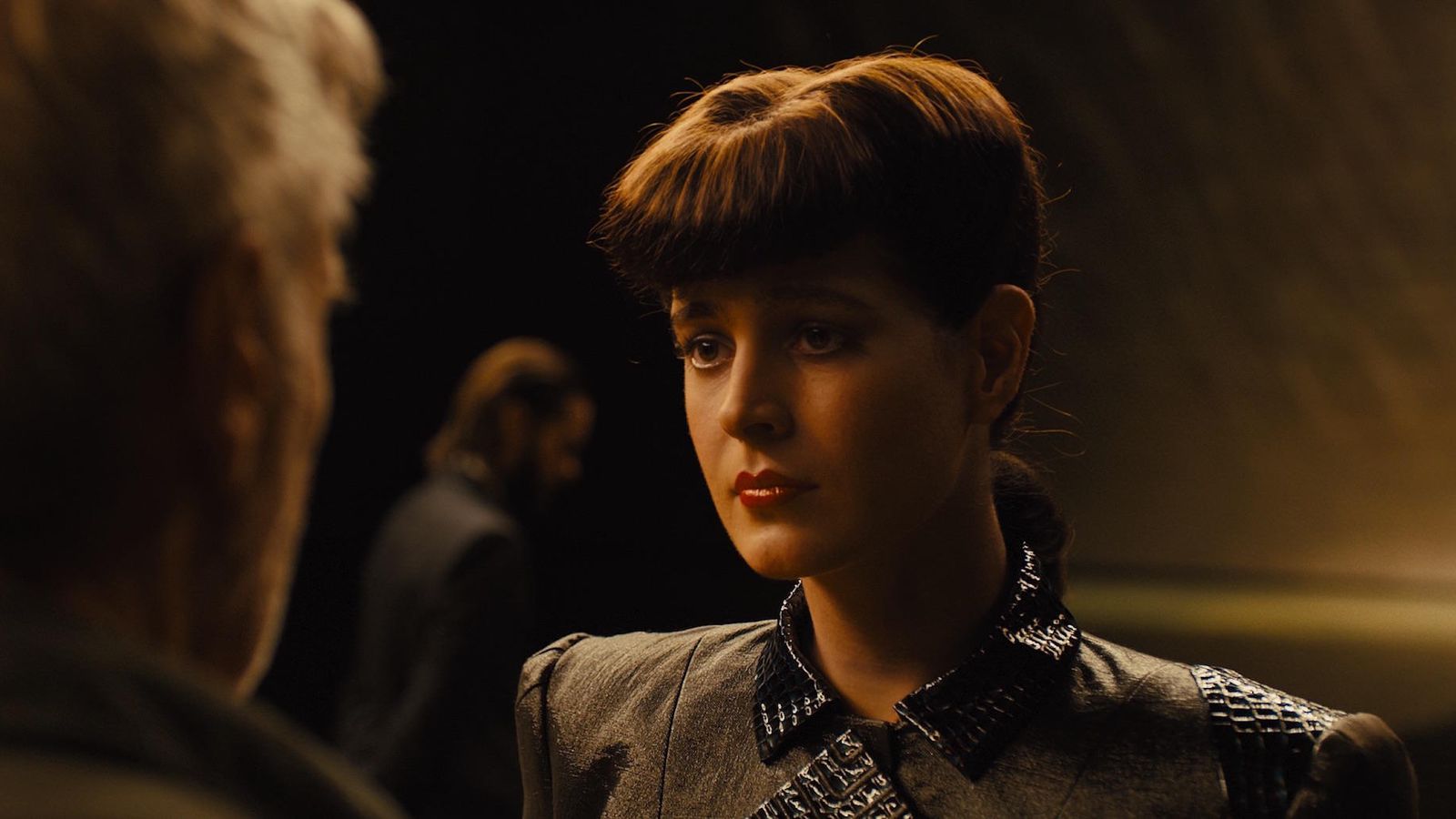During Phillip K. Dick’s research on Nazi Germany for The Man in the High Castle, he came across a cache of Gestapo documents stashed in the closed stacks at UC Berkeley’s library, including the diary of an SS officer stationed in Warsaw, near the Jewish ghetto. One entry was the man griping that his sleep was being interrupted by the cries of starving children. Shaken, Dick later reflected in an interview “It is not human to complain in your diary that starving children are keeping you awake … There is among us something that is a bipedal humanoid, morphologically identical to the human being but that is not human.”
That compassion is what’s supposed to separate us from androids, and the collective human failure to always pass a Voight-Kampff test is the knife’s edge (blade’s edge?) paradox that’s part of what makes the original “Blade Runner” such an intriguing cult puzzle. Conversely, “Blade Runner 2049’s” philosophical themes are more elusive, if not downright murky (like its cinematography) and let’s let Ridley Scott say it: “[That movie] was fucking way too long.” The only recurring theme that’s crystal-clear is the expendability of women. “Blade Runner 2049” is extraordinarily brutal to female bodies. (Maybe that’s why it bombed at the box office, with only 29% of ticket sales going to women.) What begins as a egalitarian attitude to nudity (there are flaccid penises on some inert replicant bodies on display in a lab morgue) quickly turns into the same-old acreage of female flesh, usually as a prelude to maiming, objectifying, or taking a bullet to the head.
That’s the hardest and ugliest scene in “Blade Runner 2049”: Rachel, digitally recreated as a young Sean Young, marching on screen, tilting her head a little bit, mouthing a few lines of dialogue and then getting shot in the head, execution style. OK, it’s not Rachel. It’s another clone in the Rachel model made by the Tyrell Corporation. But it’s still hard to take. And it’s the most shocking example of an ominous trend of the new technology of virtual actors treating actresses more callously than actors, both on and off-screen.
To be fair, isn’t every actor eventually a virtual actor? Just a couple bouncing photons, first off their god-given cheekbones onto raw negative or digital plate, and then from the reflective surface of the screen into our dark-dilated eyes. There’s a scene in “Blade Runner 2049” that acknowledges that truth, when the holographic girlfriend Joi consummates her relationship with K by projecting her image overtop the prostitute Mariette’s fleshy replicant body. We cheer for Joi and K. One might be a robot and the other an AI, but the movie takes great pains to emphasize how their love is real. The biggest irony is that a movie explicitly musing about how synthetic humans deserve empathy and inclusion is blind to the antithetical practice of using virtual actresses to speed up the expiration date on their already perishable careers.
For the sake of narrowing this article’s scope, let’s clarify that a motion-capture actor like Andy Serkis is not a virtual actor. Serkis is paid as an actor is paid, he wears a costume as an actor does (in this case, a digital costume) and Gollum’s presence on screen still contains Serkis’s performance. (The chrome form of the T-1000 in “Terminator 2: Judgment Day,” recreated in a computer from reference footage of Robert Patrick, can also be considered this way for our purposes.) We’re only going to discuss the descendants of “Rendez-vous à Montréal” (1987), the computer animated short starring 3D approximations of Marilyn Monroe and Humphrey Bogart. This definition of a virtual actor can range from compositing a face or head onto a stand-in’s body (Brad Pitt in “The Curious Case of Benjamin Button,” Brandon Lee in “The Crow,” Oliver Reed in “Gladiator,” Jeff Bridges in “Tron: Legacy“) to using age smoothing software (also Pitt in “Benjamin Button,” Robert Downey Jr. in “Captain America: Civil War,” Kurt Russell in “Guardians of the Galaxy“) to creating an entire virtual body (Ryan Reynolds in “Deadpool“).
Every example cited above is of a man, and every one of those actors got to appear in other scenes in those movies as their usual, sometimes wrinkly, unaugmented selves as well. (Wrinkly and unaugmented is how Peter Cushing’s avatar appeared in “Rogue One: A Star Wars Story,” too.) Actresses barely get to appear wrinkly in movies anyway, and now with the advent of virtual possibilities Hollywood has jumped on the chance to find another way to exclude them based on age. I’m not the first critic to notice this— Nate Jones pointed it out in an article in Vulture in October of last year, touching on the other egregious example of a young virtual Carrie Fisher in “Rogue One”.) When it came to creating the virtual Rachel, Young did have some involvement (presumably with her consent, and was presumably financially compensated. As much as Robert Downey, Jr. was for “Captain America: Civil War”? Probably not.).

The Rachel that appears on-screen was recreated by British effects house MPC from archival photographs and footage, with Young coming in to have her present-day face scanned digitally and give body stand-in Loren Peta some movement consultation. But that’s not her body on screen, it’s not her voice, and that’s not her face. And if it’s not her real self in other scenes of the movie, like it was for Downey, Jr. or most of the other actors on the list above, it’s not her payday. To paraphrase Rachel in the original “Blade Runner,” ever since she got old and “difficult,” that death-knell slur for actresses, Sean Young’s no longer in the business … she is the business. And the sadism with which Rachel is treated in her 180-some seconds of screen time is utterly cold-blooded and unnecessary, almost as jarringly cruel as the way the bitchy assistant Zara in “Jurassic World” was subjected to a virtual mauling and death totally out of proportion to her “crimes.”
Let’s play Tyrell’s advocate for a moment here: is Villeneuve merely accurately … well, replicating the disposability and callousness of the original “Blade Runner” towards its replicants, especially Pris and Zhora? Is the point that all replicants are disposable, and do we merely notice the way the equally callous way female replicants are dispatched because it twinges at our chivalry? (It has crossed his mind. As he put it in an interview with Gizmodo: “Cinema is a mirror on society. Blade Runner is not about tomorrow; it’s about today. And I’m sorry, but the world is not kind to women.”) But this argument isn’t about one female character in one dark and dystopian movie. It’s about Young, Hollywood exile, and all the other young actresses who are at the brunt of a new way to make them disposable. Rachel in “Blade Runner 2049” is a stand-in for all of them, given the merest morsel of time in the sun before she’s shot in the head.
Rachel has always been special, and not just because she’s the most advanced replicant ever made. In the seduction scene (or rape scene, as can be equally argued) in the original movie, she is reluctant to the point of tears to go to bed with Deckard because she doesn’t trust whether her feelings of love are real. In the moment she quavers “Put your hands on me,” she is taking an unprecedented leap across the uncanny valley, trusting that this new feeling that has germinated inside her—something not included in Tyrell’s niece’s childish memories, that rogue wild thing called love that a lab cannot yet make—is true, the first real feeling she’s ever had. To have her dispatched so brutally sends shockwaves that resonate beyond the narrative into the strange and merciless new world actresses must now negotiate thanks to its thoughtlessness. Hey, “Blade Runner 2049”: You know that Voight-Kampff test of yours? Did you ever take that test yourself?











